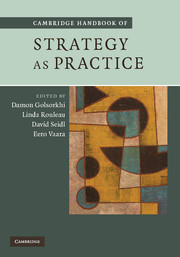Book contents
- Frontmatter
- Contents
- List of figures
- List of tables
- List of contributors
- Introduction: What is Strategy as Practice?
- PART I ONTOLOGICAL AND EPISTEMOLOGICAL QUESTIONS
- PART II THEORETICAL DIRECTIONS
- PART III METHODOLOGICAL TRACKS
- 13 Broader methods to support new insights into strategizing
- 14 Critical discourse analysis as methodology in Strategy as Practice research
- 15 Researching everyday practice: the ethnomethodological contribution
- 16 Researching strategists and their identity in practice: building ‘close-with’ relationships
- 17 Studying strategizing through narratives of practice
- PART IV APPLICATION VARIATIONS
- Author Index
- Index
- References
15 - Researching everyday practice: the ethnomethodological contribution
Published online by Cambridge University Press: 05 October 2012
- Frontmatter
- Contents
- List of figures
- List of tables
- List of contributors
- Introduction: What is Strategy as Practice?
- PART I ONTOLOGICAL AND EPISTEMOLOGICAL QUESTIONS
- PART II THEORETICAL DIRECTIONS
- PART III METHODOLOGICAL TRACKS
- 13 Broader methods to support new insights into strategizing
- 14 Critical discourse analysis as methodology in Strategy as Practice research
- 15 Researching everyday practice: the ethnomethodological contribution
- 16 Researching strategists and their identity in practice: building ‘close-with’ relationships
- 17 Studying strategizing through narratives of practice
- PART IV APPLICATION VARIATIONS
- Author Index
- Index
- References
Summary
The studies of work [Garfinkel] inspires […] [examine] the detailed and specifiable process of producing orders based on shared methods, trust, competence and attention
(Rawls 2008, p. 702)Introduction
Garfinkel originally coined the term ‘ethnomethodology’ (EM) in the 1950s to capture his central interest in members' ‘folk’ or everyday taken-for-granted methods (also called practices) or practical reasoning procedures for accomplishing a social order that constitutes sense. Garfinkel (1974, p. 16) later commented that ‘Ethno’ referred ‘somehow or other, to the availability to a member of common-sense knowledge of his society as common-sense knowledge of the whatever’. While Garfinkel's ‘daunting prose’ (Silverman, 2000: 138) may deter us from reading him first-hand, others, for example Heritage (1984), have offered accessible summaries of his work. Garfinkel's ethnomethodological stance was also subsequently taken up in a unique way by Harvey Sacks (1992; see Silverman 1998) and colleagues in the late 1960s, establishing conversation analysis (CA). Under the auspices of the ‘missing what’, both Garfinkel and Sacks argued that social scientists were missing out the observable and reportable ‘work’. In other words, the everyday ordinary activities of members whereby they make accountable and visible those entities we call, for example, ‘welfare agencies’, hospitals, factories, courtrooms, families and various other kinds of organizations/bureaucracies.
In quite diffuse ways, ethnomethodological thinking and ideas have seeped into the management and organization studies field through the work of Weick (1995, p. 11) and Giddens (1984; see Boden 1991).
- Type
- Chapter
- Information
- Cambridge Handbook of Strategy as Practice , pp. 230 - 242Publisher: Cambridge University PressPrint publication year: 2010
References
- 11
- Cited by



